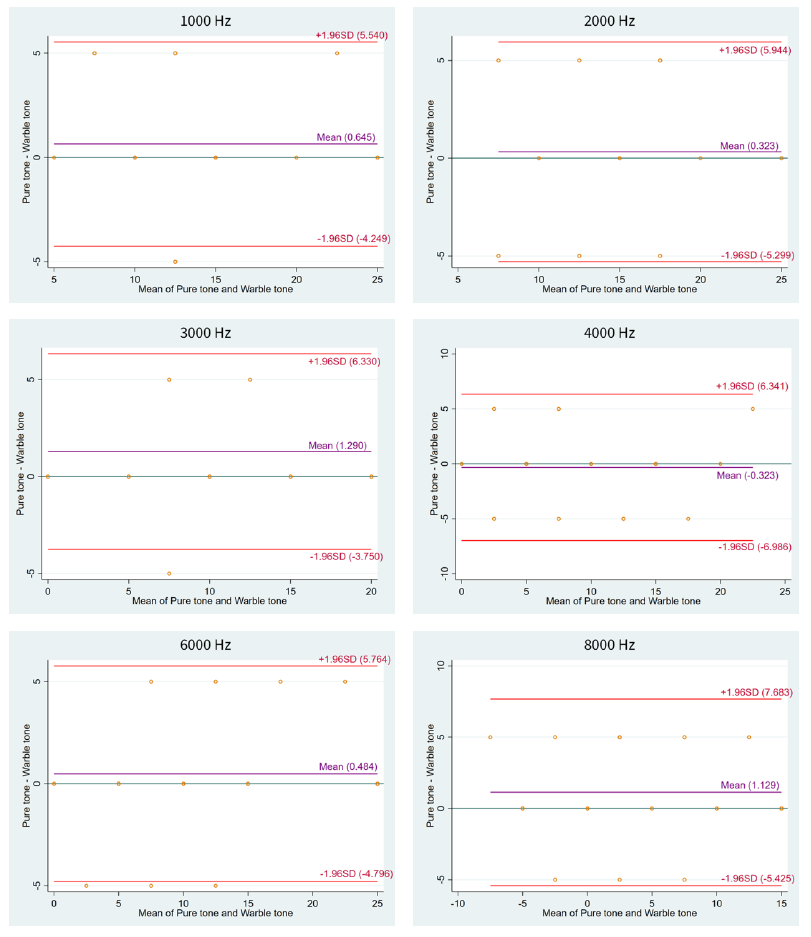การศึกษาเปรียบเทียบค่าระดับเริ่มได้ยินในคนที่มีการได้ยินปกติ โดยใช้สัญญาณเสียง Pure Tone กับเสียง Warble Tone
คำสำคัญ:
เสียงบริสุทธิ, เสียงที่มีการเปลี่ยนแปลงความถี่ในระยะเวลาหนึ่ง, ค่าระดับเริ่มได้ยินบทคัดย่อ
เสียงบริสุทธิ์ (Pure Tone) เป็นเสียงมาตรฐานที่ใช้ในการตรวจการได้ยินเพื่อวินิจฉัยชนิดและระดับของการสูญเสียการได้ยิน ปัจจุบันเครื่องตรวจการได้ยินมีเสียงต่าง ๆ ให้เลือกเพื่อใช้ในการตรวจ เช่น เสียงที่มีการเปลี่ยนแปลงความถี่ตามเวลา (Warble Tone) เสียงที่มีการเปลี่ยนแปลงความดังเป็นจังหวะ (Pulsed Tone) สัญญาณเสียงดังกล่าวจะช่วยให้ผู้ป่วยฟังเสียงตรวจได้ง่ายมากขึ้นโดยเฉพาะในผู้ป่วยที่มีเสียงดังในหู ถึงแม้ว่ามีหลายการศึกษาที่ผ่านมาเปรียบเทียบค่าระดับเริ่มได้ยินโดยใช้เสียง Pure Tone กับ Warble Tone ผลที่ได้ก็ยังไม่สอดคล้องกัน การศึกษาครั้งนี้มีวัตถุประสงค์เพื่อเปรียบเทียบค่าระดับเริ่มได้ยินเมื่อตรวจโดยใช้เสียงทั้งสอง และกำหนดว่าสามารถใช้ทดแทนกันได้หรือไม่ในคนไทย โดยทำการศึกษาในคนที่มีการได้ยินปกติจำนวน 31 หู อายุ 18-28 ปี ตรวจการได้ยินผ่านการนำเสียงทางอากาศที่ความถี่ 250-8000 Hz วิเคราะห์ข้อมูลโดยใช้ Bland-Altman plot พบว่าที่ความถี่ 250, 500, 2000, 4000 และ 8000 Hz มีค่าความแตกต่างของระดับเริ่มได้ยินจากเสียงทั้งสองชนิดทั้งหมดอยู่ในช่วง limits of agreement ที่ระดับความเชื่อมั่นร้อยละ 95 เมื่อทดสอบด้วยสถิติ Wilcoxon signed rank test มีเพียงความถี่ 3000 Hz มีค่าความต่างของระดับเริ่มได้ยิน 1.29 dB อย่างมีนัยสำคัญทางสถิติ อย่างไร ก็ตามค่าความต่างของระดับเริ่มได้ยินที่ได้ มีค่าไม่เกิน 5 dB สามารถนำไปใช้ทางคลินิกได้ ภายใต้เงื่อนไขการปรับความดังเพิ่มครั้งละ 5 dB และเสียง Warble Tone มีค่า Frequency-Modulated ที่อัตราความถี่ 5 Hz และมีค่าเบี่ยงเบนอยู่ที่ ±5% จากความถี่กลาง สรุปผลการศึกษาครั้งนี้พบว่า สามารถใช้เสียง Warble Tone แทนเสียง Pure Tone ในการปฏิบัติงานในคลินิกได้
เอกสารอ้างอิง
American Speech-Language-Hearing Association. Guidelines for manual pure-tone threshold audiometry. [Internet] 2005 [cited 2020 Dec 22] Available from: https://www.asha.org/ policy/gl2005-00014
Thai Speech-Language and Hearing Association. Professional Ethics and Standards of Thai Speech-Language and Hearing. Khonkaen: Khonkaen Print; 2000.
Dancer J, Ventry IM, Hill W. Effects of stimulus presentation and instructions on pure-tone thresholds and false-alarm responses. Journal of Speech and Hearing Disorders. 1976;41:315–24.
Dockum GD, Robinson DO. Warble tone as an audiometric stimulus. Journal of Speech and Hearing Disorders 1975;40(3):351-6.
Stabb WJ. Comparison of pure-tone and warble-tone thresholds [dissertation]. Michigan: Michigan State University; 1971.
Stephens MM, Rintelmann WF. The influence of audiometric configuration on pure-tone, warble-tone and narrow-band noise thresholds of adults with sensorineural hearing losses. Journal of the American Audiology Society. 1978;3(5):221-6.
Reilly N. Frequency and amplitude modulation audiometry. AMA archives of otolaryngology. 1958;68(3):363–6.
Gardner MB. A pulse‐tone technique for clinical audiometric threshold measurements. The Journal of the Acoustical Society of America. 1947;19(4):592-9.
Barry SJ, Resnick SB. Absolute thresholds for frequency-modulated signals: Effects of rate, pattern, and percentage of modulation. Journal of Speech and Hearing Disorders 1978; 43:192–9.
Lentz JJ, Walker MA, Short CE, Skinner KG. Audiometric testing with pulsed, steady, and warble tones in listeners with tinnitus and hearing loss. American Journal of Audiology 2017;26(3):328-37.
Franklin CA, Franklin TC, Franklin JL. Comparing pure-tone, pulsed, and warbled tone thresholds in adults at 3000 and 6000 Hz. American Journal of Audiology 2011; 20(1):42-7.
Zakaria NA, Rosli R, Zam TZ. Hearing threshold in audiometry testing: Pure tone versus warble tone. International Journal of allied health sciences 2021;5(6):2530-4.

ดาวน์โหลด
เผยแพร่แล้ว
ฉบับ
ประเภทบทความ
สัญญาอนุญาต
บทความทุกบทความที่ตีพิมพ์ในวารสารการพัฒนางานประจำสู่งานวิจัย (JPR2R) ถือว่าเป็นลิขสิทธิ์ของวารสารการพัฒนางานประจำสู่งานวิจัย คณะสิ่งแวดล้อมและทรัพยากรศาสตร์ มหาวิทยาลัยมหิดล





